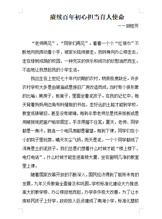初中英语语法知识点
知识是一切力量的源泉,是文人骚客抒发豪情壮志的资本;是国家兴旺发达,科学发展的力量源泉;是人们独立于世界文化之林的基石。下面小阅给大家分享一些初中英语语法知识点,希望能够帮助大家!

初中英语语法知识点1
宾语从句
1. 宾语从句的含义
充当主句宾语的从句叫做宾语从句。
如:She knew that the teacher had seen the film.
她知道这位老师看过这部电影。
“that the teacher had seen the film”做 knew 的宾语,同时又是由连接词 that 引导的从句,所以它叫做宾语从句。
2. 宾语从句的分类
(1)动词宾语从句:顾名思义,它是位于动词后面的宾语从句。
如:He asked whose handwriting was the best in our class.他问我们班上谁的书法最好。
(2)介词宾语从句:顾名思义,它是位于介词后面的宾语从句。
如:I agree with what you said just now.我同意你刚才说的话。
(3)形容词宾语从句:顾名思义,它是位于形容词后面的宾语从句。
如:I am afraid that I will be late. 恐怕我要迟到了。
3. 引导宾语从句的连接词
(1)that:没有含义,在宾语从句中不做成分
(2)whether/if:表示是否,在宾语从句中不做成分。
I don't know if /whether he still lives here after so many years. 我不知道这么多年后,他是否还住在这里。
(3)连接代词:what, which, who, whom, whose(在宾语从句中做主、宾、表和定语)
连接副词:where, when, how, why(在宾语从句中做状语)
The small children don't know what is in their stockings.(what 在宾语从句中做主语)
这些小孩子不知道什么在他们的长筒袜里。
Could you tell me why you were late for the meeting this morning?(why 在宾语从句中做原因状语)
你能告诉我为什么你今天早上开会迟到吗?
4. 在做宾语从句的题目时应注意两点
(1)时态:
①当主句是现在时态时,宾语从句可以根据需要使用任何时态。
I don't know when he will come back.我不知道他将何时回来。
He tells me that his sister came back yesterday.他告诉我他姐姐昨天回来了。
②当主句是过去时态时,宾语从句必须是一种过去的时态。
She asked me if I knew whose pen it was.她问我是否知道这是谁的钢笔。
He said that he could finish his work before supper.他说他会在晚饭前完成工作。
③当表示客观事实或普遍真理的句子做宾语从句时,任何时候都用一般现在时。
The teacher said that the earth goes round the sun.老师说过地球绕着太阳转。
(2)语序:
任何从句都使用陈述句语序,宾语从句当然也不例外。
同学们只要掌握了以上内容,应对宾语从句的题目就不成问题了。
初中英语语法知识点2
used to 的用法
used to 意为过去常常做某事。
used to 的用法
1. 肯定句:used这个词没有人称的变化,to后面接动词原形。
否定句是didn’t use to….
When I was a child, I didn’t use to like apples.
当我还是孩子的时候我不喜欢苹果。
疑问形式是Did you use to…?
Where did you use to live before you came here?
当你来这儿之前你住哪儿?
2. 含有used to 的句子的反意疑问句不要usedn’t + 主语,而用didn’t + 主语。
——He used to smoke, didn’t he?
——他过去常常吸烟,是吗?
Yes, he did./ No, he didn’t.
是的,他吸。/ 不,他不吸。
初中英语语法知识点3
介词by的用法
1. 意为“在……旁”,“靠近”。
Some are singing and dancing under a big tree. Some are drawing by the lake.
有的在大树下唱歌跳舞。有的在湖边画画儿。
2. 意为“不迟于”,“到……时为止”。
Your son will be all right by supper time.
你的儿子在晚饭前会好的。
How many English songs had you learned by the end of last term?
到上个学期末你们已经学了多少首英语歌曲?
3. 表示方法、手段,可译作“靠”、“用”、“凭借”、“通过”、“乘坐”等。
The monkey was hanging from the tree by his tail and laughing.
猴子用尾巴吊在树上哈哈大笑。
The boy’s father was so thankful that he taught Edison how to send messages by railway telegraph.
孩子的父亲是那么的感激,于是他教爱迪生怎样通过铁路电报来传达信息。
4. 表示“逐个”,“逐批”的意思。
One by one they went past the table in the dark.
他们一个一个得在黑暗中经过这张桌子。
5. 表示“根据”,“按照”的意思。
What time is it by your watch?
你的表几点了?
6. 和take , hold等动词连用,说明接触身体的某一部分。
I took him by the hand.
我拉住了他的手。
7. 用于被动句中,表示行为主体,常译作“被”、“由”等。
English is spoken by many people.
英语被许多人说。(即“许多人讲英语。”)
初中英语语法知识点4
must/might/could/can
1. must
(1)must 表示主观看法,意为“必须”。
如:You must stay here until I come back.
Must I hand in my homework right now?
对must引导的疑问句,肯定回答为must,否定回答为needn’t 或don’t have to .
如:—Must I finish my homework?
—No, you needn’t.
(2)must也可以表示有把握的推测,意为“ 一定,肯定”,用于肯定句。
如: The light is on, so he must be at home now.
其否定形式mustn’t表示“禁止,不许”。
如:You mustn’t play with fire.
You mustn’t be late.
2. could
(1)can的过去式,意为“能、会”,表示过去的能力。
如:He could write poems when he was 10.
(2)could在疑问句中,表示委婉请求的语气,此时could没有过去式的意思。
如:Could you do me a favour?
—Could I use your pen?
—Yes, you can.(注意回答)
3. might
might为may的过去式。might表示推测时,表示可能性低于may(此时might没有过去式的意思),当请求讲时,比may的语气更委婉。
He is away from school. He might be sick.
Might I use your dictionary?
4. can
(1)表示能力,一般译为“能、会”,尤其指生来具备的能力。
如:She can swim fast, but I can’t .
(2)表示许可,常在口语中。
如:You can use my dictionary.
(3)表示推测,意为“可能”,常用于否定句和疑问句中,此时can’t译为“不可能”。
如:—Can the news be true?
—No, it can’t be our teacher. He is on a visit to the Great Wall.
初中英语语法知识点5
被动语态
被动语态由助动词be加及物动词的过去分词构成,助动词be有时态,人称和数的变化。被动语态的时态是由be的时态决定的,be是什么时态,全句就是什么时态,be动词后面的过去分词不变。
1. 各种时态的被动语态结构如下:
一般现在时的被动语态:主语+am / is / are (not)+过去分词
一般过去时的被动语态:主语+was / were +过去分词
现在完成时的被动语态:主语+have / has +been +过去分词
一般将来时的被动语态:主语+will +be +过去分词
过去将来时的被动语态:主语+would / should + be +过去分词
过去进行时的被动语态:主语+was / were + being +过去分词
过去完成时的被动语态:主语+had + been +过去分词
情态动词的被动语态:情态动词+be+过去分词
2. 被动语态的用法
(1)不知道或没有必要说明动作的执行者是谁,不用by+动作执行者短语。
Football is played widely all over the world.
全世界都广泛地踢足球。
(2)强调动作的承受者。
The bank was robbed yesterday afternoon.
昨天下午这家银行遭到抢劫。
(3)作客观说明时,常采用一种被动语态句型。
It is reported that about twenty children have died of flu in the USA.
据报道美国大约二十名儿童死于流感。
3. 主动语态的句子变为被动语态的步骤
(1)把原句中的宾语变为主语
(2)动词改为被动形式,即be+过去分词
(3)原来的主语,如果需要的话,放在by后面;如果没必要,可省略。
初中英语语法知识点相关文章:
★ 初中英语语法知识点分享
★ 初中英语语法知识点提纲
★ 英语语法知识点总结
★ 初中英语语法动词不定式的讲解
★ 英语语法相关重点知识讲解
★ 7年级英语语法
★ 人教版七年级上册英语复习归纳笔记





